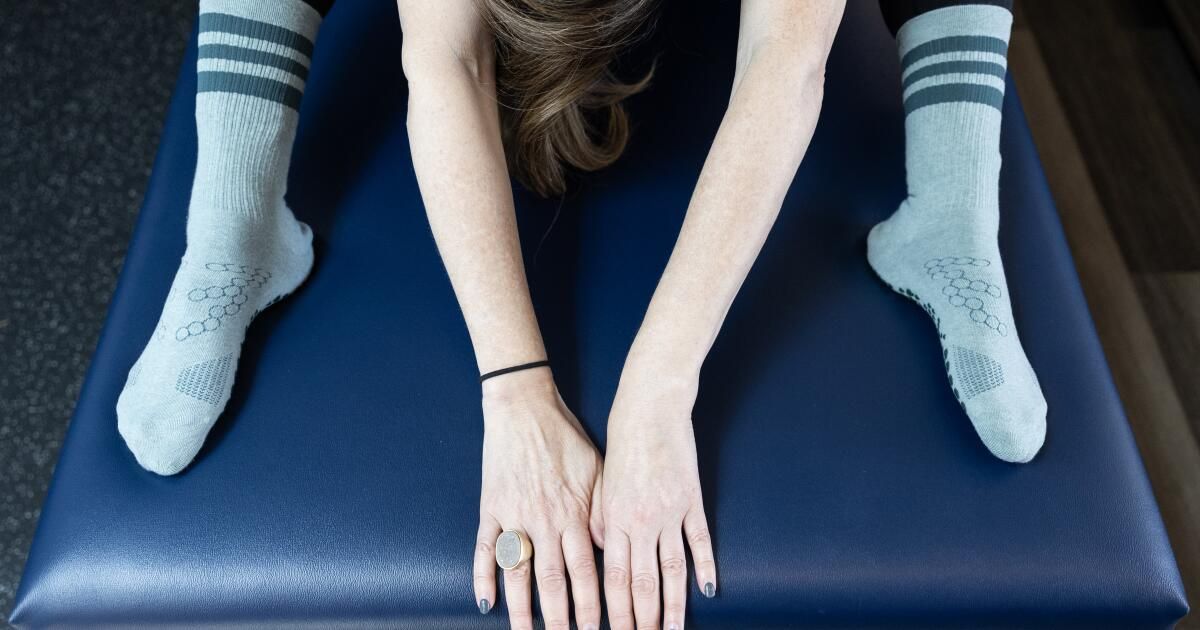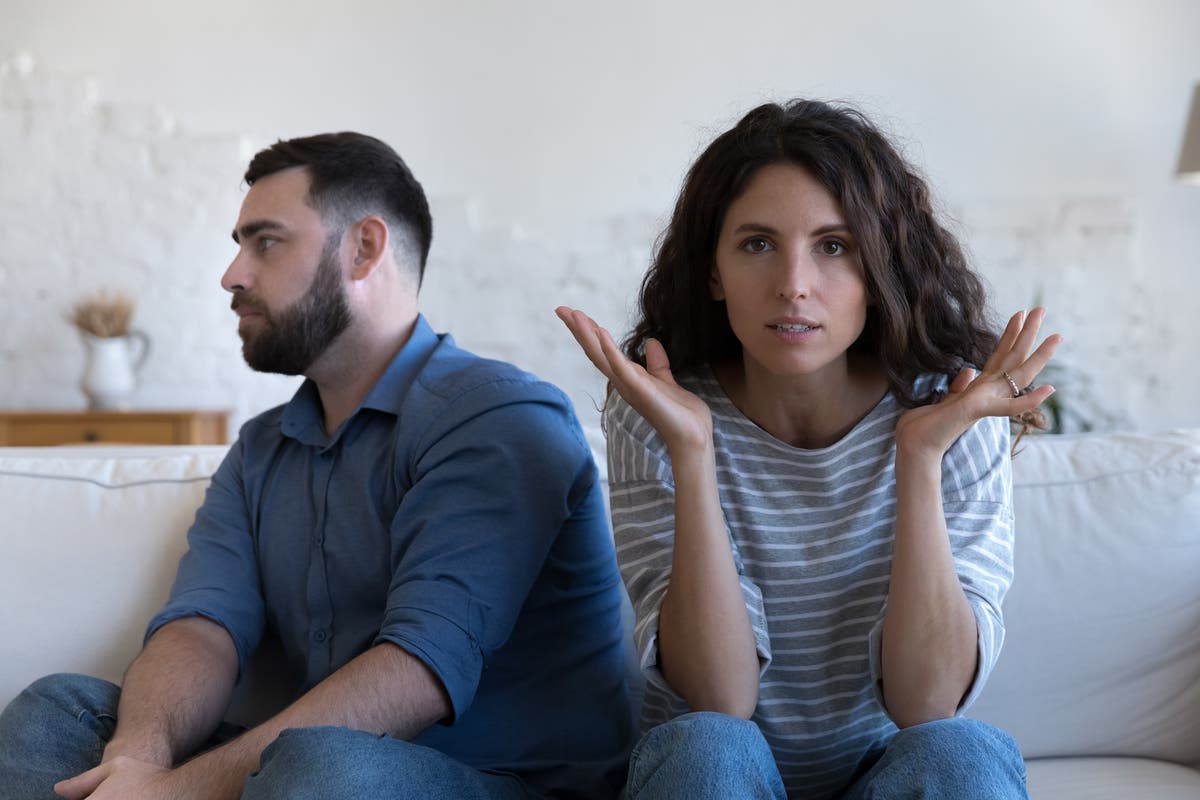The signs seemed to proliferate around Los Angeles, along Sunset Boulevard in Echo Park, in mini-centocopies in Pacific Coast Highway, on lateral streets in Glendale and Venice: stretching, stretching area, stretching, stretched.
The 50 -minute stretch session of Deborah Vankin included 13 stretching on both sides of his body.
(Luke Johnson / Los Angeles Times)
He was curious about stretching for a while. But I never thought about visiting a study. Of course, “recovery” is a growing trend in physical aptitude, which means rejuvenating the muscles, tendons and the central nervous system between exercise sessions by focusing on hydration, adequate nutrition, sleep and, yes, active stretching to maximize athletic performance. But I have three foam rollers, one soft, one pointed, one padded and even use them at home. I am also far from an extreme athlete, preferring quick walking for cardio and basic strength training.
Why would I lead to a mini-center and pay someone to stretch me? What would that be? look I like it, and was it worth it?
The questions rumbled in my head while I recently spent another stretch, is in Beverly Boulevard, near Hollywood. Then I called them.
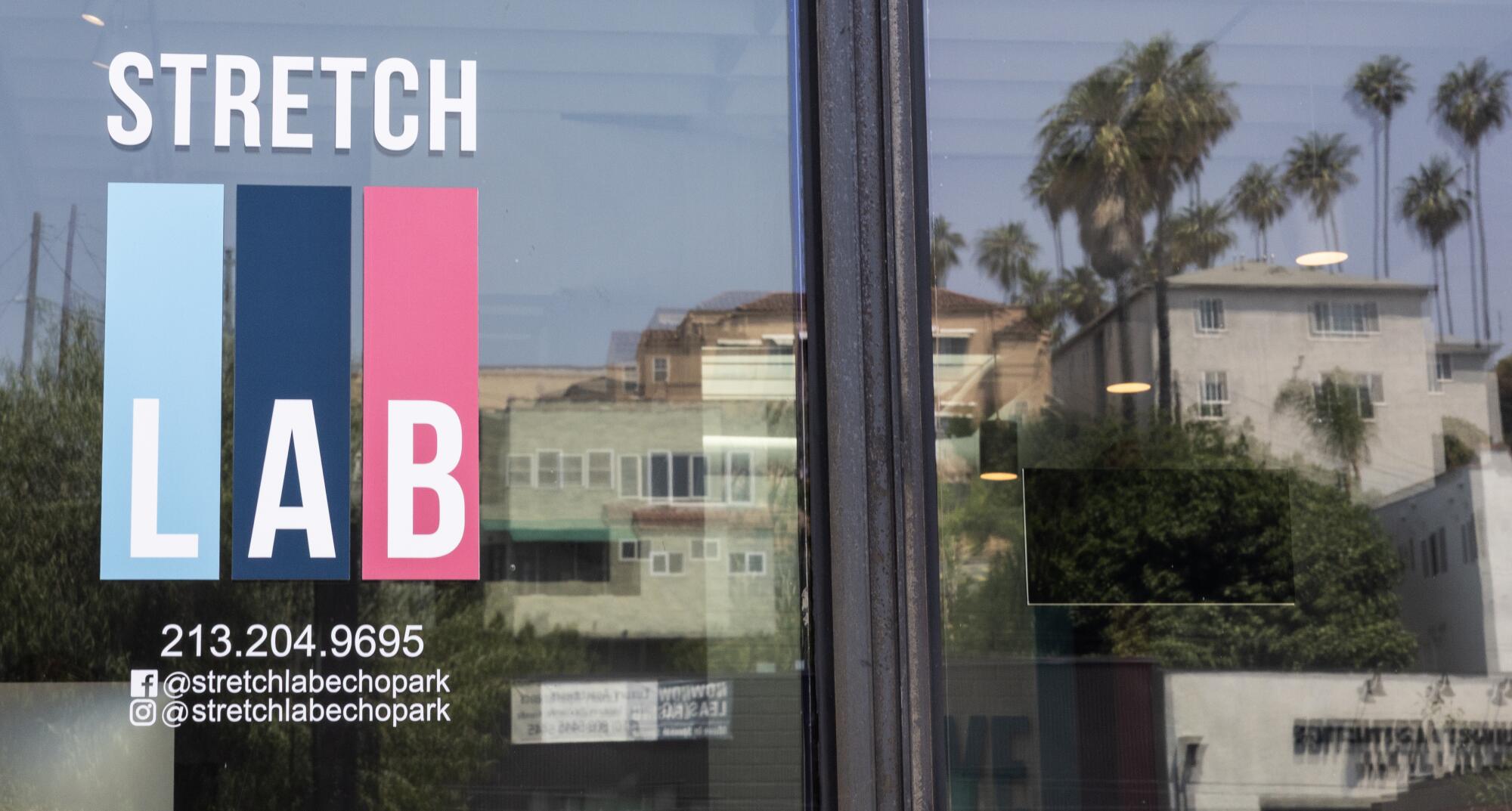
Stringlab has 15 locations in the Los Angeles area, even in Echo Park.
(Luke Johnson / Los Angeles Times)
It is Stretchlab, who opened his first study in Venice in 2015, now he has more than 500 studies throughout the country, 15 of them in the Los Angeles area. Their clientele are generally serious athletes, older adults and desktop workers who fight with rigidity and want to work in their mobility, or in those healing lesions and other conditions. They extend more deeply, in positions in which they could not physically enter on their own. Many of them appreciate the intimacy and responsibility of working with a professional, one by one. And it may be useful to have a professional, with a trained eye, isolate asymmetries in their bodies and guide their stretch, especially for those who suffer from chronic pain or are healing an injury, says Marketing director of Stretchlab, Gabi Khowploum.
“We see many people who say: 'Hey, I'm having back pain,'” says Khowploum. “And they come to stretch it, but they could be that they are having problems with the mobility of the hip, they simply do not realize.”
Stretching therapists, or “flexologists”, as they are sometimes called, are not doctors. Chiropractic, physiotherapists and some massage therapists are trained in assisted stretching, but stretched therapists cannot do what they do. Stretching therapists do not diagnose and treat injuries; They do not provide spinal or articular manipulation, images such as radiographs or computerized tomographies or massages. Instead, they focus on stretching the muscles and fascia to increase flexibility and mobility. Nor is there a national certification for stretching therapists, since it exists for physiotherapists and chiropractic, although most parked therapists are internally certified by their respective employers.
Dr. Jeremy Swisher, a sports medicine doctor at UCLA Health, says that assisted stretching can help increase the range of movement and flexibility, stimulate blood flow, which helps healing and helping with posture, particularly for sedentary populations, as well as relieving stress. Made consistently, in the long term, it can help with relief and the rigidity of pain and, possibly, prevent injuries. But he warns “is not a cure.”
“It's just a piece of puzzle,” he says. “Strength training and other forms of exercise are equally important, in the long term.” Swisher also warns that assisted stretching could exacerbate existing injuries “such as a sprain or acute tear without being eliminated by a first doctor.” And for those with hypermobility syndromes, which means too flexible joints, “it is important to keep in mind that the increase in stretching could lead to joint dislocations.”
On a recent Friday afternoon, Stretchlab in Echo Park was more busy than I expected. Several clients put on the back in what looked like massage tables, since their flexologists rolled, twisted or pressed on the parts of their body, a limb on the shoulder here, a spinal turn there.
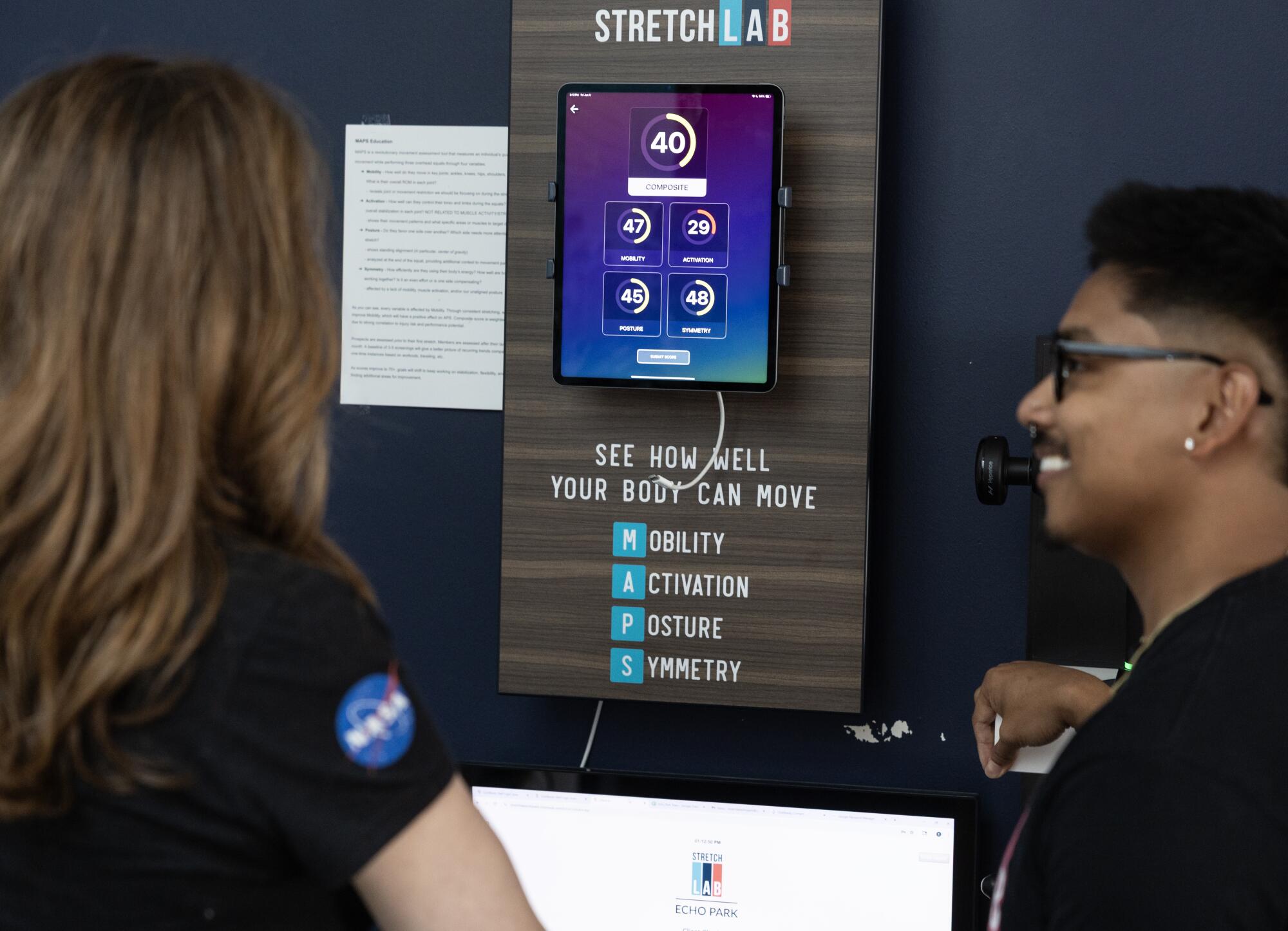
The flexologist Joel Badilla walks Deborah Vankin through the map evaluation process.
(Luke Johnson / Los Angeles Times)
My practitioner, Joel Badilla, accompanied me through the evaluation before my 50 -minute session (such as a “fall”, cost me $ 125, but prices differ depending on the package and location). Stringlab uses a 3-D body scan tool called Maps, which Trx Training developed for them. Evaluate mobility (movement range), activation (movement quality), posture and symmetry to isolate adjusted or unbalanced areas and personalizing a client stretch program. I made three superior squatillas in front of an iPad before Maps gave me a score in each area. (The much lower scores than I would have liked, the culprits are the tight hips and the “technological neck”, but that is the case of the desktop workers, they told me).
Then I lay on the table and Badilla raised my legs and threw them gently forward, towards him. He felt wonderful, as if my column lengthened, all the stress that I drained from my back. Then he put me through 26 stretching, 13 on each side of my body.

Joel Badilla throws gently on Deborah Vankin's legs at the beginning of his stretching session.
(Luke Johnson / Los Angeles Times)
Stringlab uses PNF stretching (proprioceptive neuromuscular facilitation), Badilla explained, which is a “thrust and release” technique. The recipient maintains the stretch for an established period of time, then pushes the resistance provided by the practitioner for a shorter period of time, then returns to a deeper version of the stretch. We did this repeatedly for different parts of the body.
Then, I felt lazy and the flow back to my car, although the feeling did not last long after my car travel home. This is because the benefits of stretching come from consistency, says Amber Donaldson, vice president of Sports Medicine Clinics of the United States Olympic and Paralympic Committee.
“Just stretching once is not beneficial,” she says. “You need two weeks, minimum, consistency to see a benefit. These [assisted stretching] Places: Paying for a series of treatments can keep it consistent with going. “
That said, there are questions about the benefits of stretching, in general, in the Community of Sports Medicine, adds Donaldson. “It is controversial. When should you do it, before or after training, and to what extent it is beneficial? The jury is still out.”
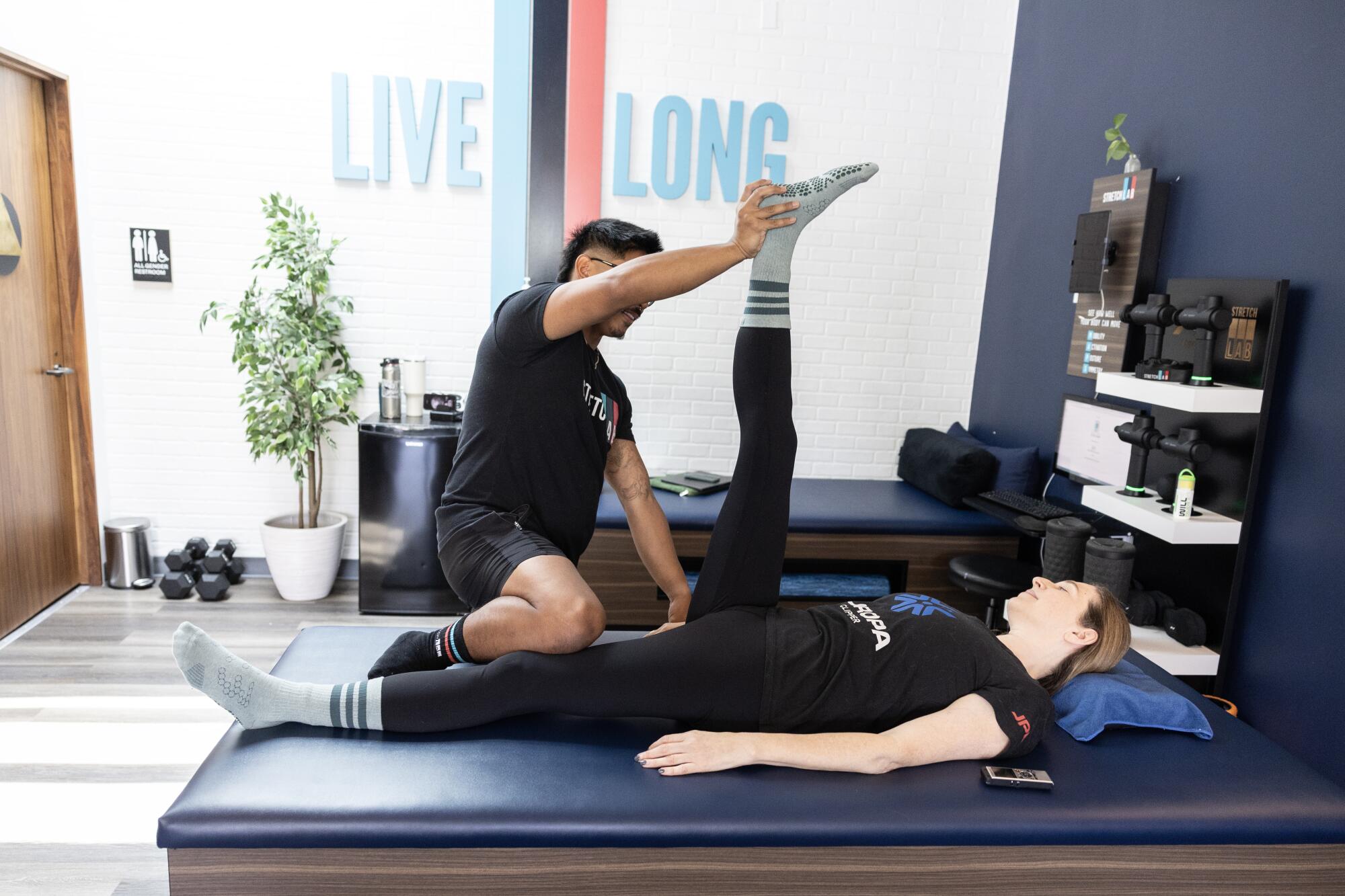
Assisted stretching, if done constantly for many weeks, can help with the rigidity, pain relief and even injury prevention.
(Luke Johnson / Los Angeles Times)
Stringlab is far from being an anomaly in Los Angeles, there are more than half a dozen assisted stretching businesses in the area, and the trend, which began to swell throughout the country in 2017-18, only seems to be growing. In addition to franchises such as stretching and stretching zone, many personal trainers offer assisted stretching, as well as most physiotherapists. Gyms like Life Time in Orange County and the Los Angeles Athletic Club offer individual assisted stretching now. Even certain massage points of sale, such as massage envy, offer assisted stretching sessions of 30 and 60 minutes.
The basic concept of assisted stretching is the same, regardless of where you go, but different studies adopt slightly different approaches.
The Redondo Beach and Rancho Palos Verdes stretch area does not use the PNF technique. On the other hand, the study (which has almost 400 points of sale throughout the country) uses a graduated stretching modality that moves the customer along a UN-10 intensity scale. Start in three “just when you start feeling stretching,” owner Deborah Ashley says: “And seven is where you want us to stop.” They also use a patented belt and straps system on an elastic table “to secure and mobilize one side of their body while we stretch the other,” says Ashley. “It acts as a second set of hands for our practitioners.”
Stretchmed in Glendale has only one location in the Los Angeles area (there are about 30 in the USA.). It is proud of not being part of an especially large franchise, says owner Carlos Rivera, and adds that the study adopts a personal and data -based approach for stretch therapy. Use the PNF stretching technique, but puts a lot of emphasis on heating before individual stretching sessions. To that end, customers perform 15 -minute heating routines in the so -called “parked coaches”, which have inclined seats, legs of the legs and safety straps for stability. A video guides them through the routine, which includes a soft movement and is intended to stimulate circulation. “You want to warm up before stretching,” says Rivera, “get a much better benefit.”
Would you do assisted stretching again?
Absolutely, it was softer than I imagined and then I felt immediate relief, particularly on my low back.
Would you do it regularly?
Not for the Stretchlab membership rate of $ 320 per month, its cheapest monthly package of four sessions of 50 minutes (prices vary slightly per location). In the stretching zone, the approximately comparable package of four 60 -minute sessions is $ 400. In Stretchmed, four 55 -minute sessions cost $ 216.
But on this particular Friday, at least, I went to the weekend feeling smaller and, if nothing more, a more or less higher inch. I take it.

